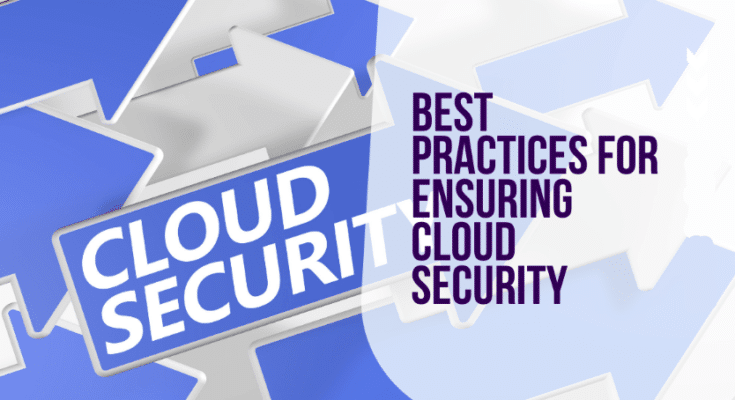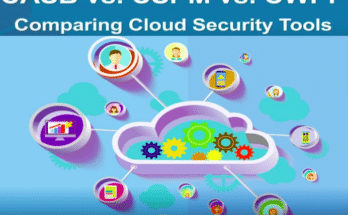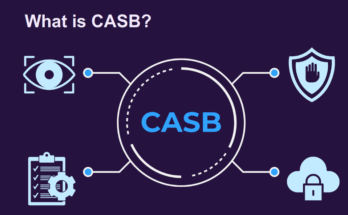Today, many enterprises use cloud services to save on cost and accelerate the business with more agile technology. The cloud offers several advantages, but it also comes with its own set of security risks.
There are various challenges that enterprises face after adopting cloud services. Some fear that they lack the talent to manage cloud services, and a few feel more concerned about data, whether it is safe in the cloud or not?
Out of all, Cloud security is a top concern for businesses. With data breaches becoming more common, companies are looking for ways to protect their information. You can also purchase various cloud security tools from the market that will provide data protection against emerging threats. Just make sure to cross-check and compare each security tool before finalizing.
Apart from cloud security tools, there are more things an enterprise must keep in mind and prepare beforehand. Here, we will discuss the main principles and a few cloud security best practices that enterprises must implement to improve security and improve performance.
Also Read
What is CASB (Cloud Access Security Broker )? – A Definitive Guide
What is Cloud Security?
Cloud Security is a set of policies, procedures, and technologies that help protect your cloud-based data against external and internal threats. As more and more businesses are moving to digital platforms and adopting cloud services, it has become essential for enterprises to also look after the security of the cloud data.
Businesses of all sizes must implement strict organizational security policies as cloud security is a growing concern. The flexibility and scalability of the cloud make it an attractive option for companies looking to save on IT costs, but the shared responsibility model can leave businesses vulnerable to data breaches and other security threats.
There are various challenges that enterprises go through when balancing productivity levels and security. Hence, to protect data and systems at all times, cloud security policies are enforced that help administrators perform cloud operations more securely.
Since cloud service providers do not provide enough coverage with their cybersecurity tools, enterprises must implement security policies and fill in this gap.
There are a few vital tools provided by CSP vendors and customers, such as Cloud Security Posture Management (CSPM), Zero Trust Network Access (ZTNA), Cloud Access Security Brokers (CASBs), etc., that can also be used to protect data from unauthorized access.
To learn more about how we can help secure your data in the cloud, we have listed a few cloud security best practices and solutions to choose from.
Principles of Cloud Security
Cyber attackers use several malicious programs and automated bots to target cloud-based services and solutions. Hence, enterprises must establish clear basic principles that define their approach to cloud security:
1. Security approach for cloud data must be based on the platform
Each cloud service requires a different strategy and solution to detect bots. You can no longer depend on a single solution to fulfill all your cloud security needs. Hence, it is essential to implement security controls and policies less vulnerable to security misconfigurations and nearest to the data storage location.
2. Consider yourself a target
Cyber attackers target businesses of all sizes and do not restrict themselves only to big companies and enterprises. Hence, another good principle is to assume yourself to be a target and perform continuous monitoring and test for potential vulnerabilities. Also, prepare yourself beforehand by maintaining cloud security best practices.
3. Security is primarily concerned with network isolation
Implement firewalls inside your system and create security boundaries to isolate the network and prevent data from breaches and compromising accounts. By establishing different security zones, enterprises can prevent their data and systems from attackers.
Cloud Security Best Practices
We have listed a handful of cloud security best practices that ensure better security across cloud environments. If you are looking forward to implementing cloud solutions for your business continuity and better productivity, consider these tips and protect your applications against emerging threats.
Phase 1: Identify cloud usage state and associated risks
Under this phase, it is essential for enterprises to firstly understand their current state and assess associated risks while integrating cloud solutions. The only way to do this is to identify and classify sensitive data. Secondly, perform continuous monitoring and check who accesses this data. Cross-check user roles, device types, access controls, and other factors for better security.
In enterprises, chances are high that employees might sign up for a few seemingly harmless cloud services. Hence, monitor your system usage and discover these unknown services to check if they carry any potential risks. Also, a few cloud service settings can result in exploitable vulnerabilities if not properly configured. Hence, make sure to configure all encryption and network controls.
Lastly, perform full-time monitoring and track signs of malicious usage of cloud data to mitigate data losses.
Phase 2: Protect your cloud environment
In the second phase, it is essential to understand the risk profile and implement policies based on the level of risk to protect cloud security. Once you have classified sensitive data, assign controls and strict security policies to each data stored in the cloud. Also, educate your users on what actions must be implemented if the policies break out.
Practice encryption keys to protect data from outsiders or unauthorized users. It is best to have your own encryption keys when regulating data to have full control and assurity of 100% security.
Another key point is to immediately enforce access control and sharing control policies as the data reaches the cloud. Limit the access to share files and allow only authorized users to perform such actions.
Cloud service provides the benefit to share data anywhere, anytime from any device, as long as you have an internet connection. However, this can also exploit your security vulnerabilities. Hence, block access from an unknown device and stop it from accessing or downloading the service.
Another important aspect is to implement bot detection and mitigation solution that help in monitoring and analyzing traffic activities in real-time. These solutions are cost-effective and defend against bad bots. Similar to bot detection tools, you must also use an anti-malware solution on your OS and virtual network to protect infrastructure from breaches.
Phase 3: Responding to attacks and issues.
Earlier, we established best practices that protected your data against emerging cybersecurity threats and ensured the smooth functioning to cloud infrastructure. However, even the cloud security best practices cannot guarantee 100% protection. Hence, you must know how to respond to malicious attempts and stay secure.
When you share or access data from unknown or unmanaged devices, there are high chances they may carry potential risks. Hence, you must consider identifying access scenarios as high risks and implement multi-factor authentication features. The additional steps of verification help determine if it is a legitimate user or the attacker.
Also, implement new policies or update access policies when new cloud services are integrated into your existing infrastructure. Through this practice, you can block access to risky profiles and alert the administrators that the implemented security protocols are not properly executed.
Also Read
Top 11 Cloud Security Threats and Best Practices to Mitigate Them
Choose the Right Cloud Security Solution
Cloud security is a complex and ever-changing field. There are a number of potential security risks that need to be taken into account when using cloud-based services. To ensure the security of your data, it is important to work with a cloud security provider that has the experience and expertise to keep your data safe.
There are various factors one must consider when selecting a cloud service provider, such as:
Certifications and Standards
Make sure to connect with cloud service providers that comply or base their policies on international security standards such as ISO 27001 or the government’s Cyber Essentials Scheme. Certifications and Standards might not help determine which CSP is appropriate but can play a key factor in shortlisting potential suppliers.
Technologies
There are a few large-scale public cloud providers that offer limited support. Hence, it is important to check if the selected provider offers good support services or not? Also, check if the preferred technologies align with the current environment.
Information security
Cloud Service Providers’ data and security systems do not provide enough coverage but still are beneficial. Make sure to check if the information security controls supported by the provider demonstrate risk-based features? Also, check if the user access and activities are auditable.
Cross-check if the selected platform provides internal security audit reports and incident reports.
Choosing the right cloud solution is not an easy task. One must keep various factors in mind when moving data to the cloud.
A cloud-based solution makes it easy for users to access data from anywhere and lower upfront costs. But, it also increases the risk of exposure and data loss. Hence, if you are moving data to the cloud, make sure to adapt the above-listed best practices and principles of cloud security for good results.
Also, adopt a cloud solution that offers reliable security and storage capabilities. The advanced features supported by the trusted cloud service providers help avoid the risk of data loss, cyberattacks, and further help improve productivity.
What’s Next: Click here to schedule a free demo with the Perimeter 81 team to secure your Cloud infrastructure.




